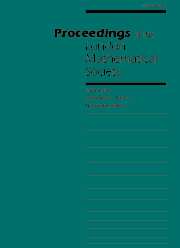Article contents
GAUSSIAN GROUPS AND GARSIDE GROUPS, TWO GENERALISATIONS OF ARTIN GROUPS
Published online by Cambridge University Press: 01 November 1999
Abstract
It is known that a number of algebraic properties of the braid groups extend to arbitrary finite Coxeter-type Artin groups. Here we show how to extend the results to more general groups that we call Garside groups.
Define a Gaussian monoid to be a finitely generated cancellative monoid where the expressions of a given element have bounded lengths, and where left and right lowest common multiples exist. A Garside monoid is a Gaussian monoid in which the left and right lowest common multiples satisfy an additional symmetry condition. A Gaussian group is the group of fractions of a Gaussian monoid, and a Garside group is the group of fractions of a Garside monoid. Braid groups and, more generally, finite Coxeter-type Artin groups are Garside groups. We determine algorithmic criteria in terms of presentations for recognizing Gaussian and Garside monoids and groups, and exhibit infinite families of such groups. We describe simple algorithms that solve the word problem in a Gaussian group, show that these algorithms have a quadratic complexity if the group is a Garside group, and prove that Garside groups have quadratic isoperimetric inequalities. We construct normal forms for Gaussian groups, and prove that, in the case of a Garside group, the language of normal forms is regular, symmetric, and geodesic, has the 5-fellow traveller property, and has the uniqueness property. This shows in particular that Garside groups are geodesically fully biautomatic. Finally, we consider an automorphism of a finite Coxeter-type Artin group derived from an automorphism of its defining Coxeter graph, and prove that the subgroup of elements fixed by this automorphism is also a finite Coxeter-type Artin group that can be explicitly determined.
1991 Mathematics Subject Classification: primary 20F05, 20F36; secondary 20B40, 20M05.
Information
- Type
- Research Article
- Information
- Proceedings of the London Mathematical Society , Volume 79 , Issue 3 , November 1999 , pp. 569 - 604
- Copyright
- 1999 London Mathematical Society
- 161
- Cited by

